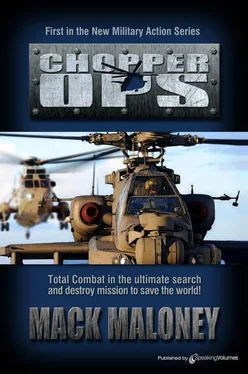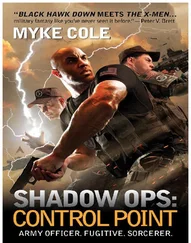Mack Maloney - Chopper Ops
Здесь есть возможность читать онлайн «Mack Maloney - Chopper Ops» весь текст электронной книги совершенно бесплатно (целиком полную версию без сокращений). В некоторых случаях можно слушать аудио, скачать через торрент в формате fb2 и присутствует краткое содержание. Город: Naples, FL, Год выпуска: 2011, ISBN: 2011, Издательство: Berkley, Жанр: Боевик, на английском языке. Описание произведения, (предисловие) а так же отзывы посетителей доступны на портале библиотеки ЛибКат.
- Название:Chopper Ops
- Автор:
- Издательство:Berkley
- Жанр:
- Год:2011
- Город:Naples, FL
- ISBN:978-1-61232-148-6
- Рейтинг книги:3 / 5. Голосов: 1
-
Избранное:Добавить в избранное
- Отзывы:
-
Ваша оценка:
- 60
- 1
- 2
- 3
- 4
- 5
Chopper Ops: краткое содержание, описание и аннотация
Предлагаем к чтению аннотацию, описание, краткое содержание или предисловие (зависит от того, что написал сам автор книги «Chopper Ops»). Если вы не нашли необходимую информацию о книге — напишите в комментариях, мы постараемся отыскать её.
Chopper Ops — читать онлайн бесплатно полную книгу (весь текст) целиком
Ниже представлен текст книги, разбитый по страницам. Система сохранения места последней прочитанной страницы, позволяет с удобством читать онлайн бесплатно книгу «Chopper Ops», без необходимости каждый раз заново искать на чём Вы остановились. Поставьте закладку, и сможете в любой момент перейти на страницу, на которой закончили чтение.
Интервал:
Закладка:
Its powerful engines and its substantial wing area really did make it part jet fighter.
(One strange thing about the helicopter, though, was that it could not hover—or at least not for long. Putting the Hind into a hover for more than a minute would likely burn out its engines. Like the aircraft itself, the power plants were designed to be moving forward all the time. This was not an aircraft that wanted to stay still for very long.)
Most nights they were airborne by 2130 hours. From that point they usually had a six-hour satellite window during which they could fly just about anywhere within Box 31. Much of this time they spent flying below five hundred feet. Occasionally they were forced to change course to avoid getting too near to an off-course private plane or fishing boat. To be spotted might put the whole operation in jeopardy. But their proximity to Cuba actually helped in this regard. The Cubans were known to have Hinds. If one were spotted over these waters, there could be a fairly plausible explanation: The Cubans were simply doing night maneuvers. Over the ocean. In unmarked copters.
Riding up front in the Hind was not such a bad thing. You could shoot the guns from the front seat and the Hind was loaded for bear. Its wings supported two gun pods and two missile launchers, not of Russian design, but made to look that way. Hind #1 also had an outrageously long cannon attached to its nose. This monster was able to fire gigantic 76-mm shells at a very fast rate. Get caught in the sight of this big gun, and it would be the last thing you did.
After some flying and shooting, at fish mostly, they would usually land and switch places. That was when the boring part of the night began, for the next few hours would usually be concentrated on formation flying. The Halos and the Hook would launch around midnight. Together they would proceed to a predesignated spot where the Hind would be waiting. Then they would form up and fly around in circles until 2 A.M. or so. Flying in formation was not nearly as much fun as driving the Hind solo. Doing endless orbits over the fluorescent Caribbean waters tended to drag a bit. But the mission spec said flying together and learning how to stay close in the air at night was very important, so the formation flying was done, usually with Delaney grumbling behind the wheel of the Hind throughout.
During all this, Gillis and Ricco were getting the hang of their huge copter as well. The crazy sleeping hours being what they were, Norton and Delaney rarely saw the tanker pilots on the ground—which was good for both sides. But in the air, the refuelers never missed a rendezvous point, were always on time, at the right altitude, in the right spot. Always. The CIA had asked for the best in the aerial refueling business—and they had gotten their wish.
All of the copters were rigged with in-flight refueling probes, and usually at least one hour of a night flight was devoted to hooking and unhooking with Gillis and Ricco’s fuel ship. Taking on gas in the air between two choppers was not that much different from a fighter hooking up to a KC-10 tanker, except the speeds were slower and it was all done through hoses and not static booms. Still, it didn’t take much time at all for Norton and Delaney as well as the Army Aviation pilots flying the Marine-laden Halos to learn the art of connecting with the Hook and drinking in a bunch of gas.
But in addition to all this, Gillis and Ricco had another exercise to drill for—this the most dangerous one of all. For not only were they charged with keeping all of the unit’s choppers fueled up, they also had to learn how to take on fuel themselves. From a higher source.
According to Smitz, this aspect of the mission was extremely important. So every night that first week, a C-130 Marine Corps tanker was called down from Eglin Air Force Base. With Norton and Delaney riding shotgun and spotting for the fuelers, Gillis and Ricco would maneuver their giant copter up and under a fuel hose being let out from the C-130’s right wing. On connection, the fuel would flow from the C-130 to the depleted bladders in the cargo hold of the Hook. It took the refuelers some doing to get it right the first few times, but experience and intuitive flying skills eventually won out. By the third night, the two tanker jockeys had the difficult hookup down pat.
Each time Norton saw this, he felt a little bit better about recommending the National Guard pilots for this program.
But there was still one last sticking point: The operational details of the mission were still unknown to them. They knew pretty much where they were going. And why. But they didn’t know exactly what they were supposed to do once they got there. And more important, when they were going.
But because of events on the other side of the globe, these questions were going to be answered very soon.
Chapter 14
Persian Gulf 0955 hours
The name of the oil platform was Qarah al Khalif #6.
It was a three-tiered, six-shaft exploration and pumping assembly located equidistant from the eastern shore of Iraq and the western shore of Iran, in the northernmost region of the Persian Gulf.
The platform got its name from a nearby island, and it was indeed one of a half-dozen sea pumping facilities in the area. It was owned by a consortium of oil wholesalers whose main office was located in Bahrain. Also known as Qak-Six, the platform and its five cousins held the distinction of being the only offshore pumping facilities in the region to continue operations during the Gulf War. In fact, the six Qak platforms had been protected throughout the conflict by U.S. Navy aircraft and ships, this even though both Iran and Iraq held a substantial stake in their ownership and operation. Such was the quality of crude pumped from their wells.
This was a special day on Qak-Six. It was the last day of the month. This meant not only payday for the 313 workers on the huge platform, but also the beginning of a ten-day vacation granted most of the workers once every five months.
Three ferries had been engaged by the platform’s owners to carry the workers down to Bahrain for their furloughs. Bahrain was the destination of choice for the majority of the workers—Filipinos mostly—as it was considered the most westernized of the Gulf States. Translation: There was a night life there, and if one looked hard enough alcohol could be found, and even female companionship.
It was just before ten in the morning when the first ferry, fully loaded, pulled away from the platform’s docking area. It was a cloudy raw day, not unusual for this time of year in this part of the Gulf, and the water was choppy. But this did not dampen the spirits of the workers, their pockets full of money, their bellies filled with the anticipation of stepping on dry land again.
The first ferry had just cleared the platform and the second one was maneuvering into place when a long, loud, guttural groan shook the rig. The noise was so sudden and so distinct that those few workers still left on the top tier thought it was one of the rig’s automatic stabilizers suddenly losing its footing. But the platform itself was not moving, and the catastrophic shift to one side indicating a leg was failing did not occur. Thankfully, the problem was not with the rig itself.
That was when many people saw an airplane appear on the murky horizon and relaxed. In a freak of atmospherics, the growl of the plane’s engines had proceeded it, carried, no doubt, by the twenty-five-knot westerly wind. This had caused the sudden thunderclap.
With much relief, the loading of the second ferry resumed.
It was not unusual to see aircraft flying by the oil rig. Both Iraqi and Iranian patrol planes passed by every few days, and occasionally a British, American, or even Saudi aircraft could be seen plying the skies this north in the Gulf too. Most gave the oil rig a wag of the wings and they would be off.
Читать дальшеИнтервал:
Закладка:
Похожие книги на «Chopper Ops»
Представляем Вашему вниманию похожие книги на «Chopper Ops» списком для выбора. Мы отобрали схожую по названию и смыслу литературу в надежде предоставить читателям больше вариантов отыскать новые, интересные, ещё непрочитанные произведения.
Обсуждение, отзывы о книге «Chopper Ops» и просто собственные мнения читателей. Оставьте ваши комментарии, напишите, что Вы думаете о произведении, его смысле или главных героях. Укажите что конкретно понравилось, а что нет, и почему Вы так считаете.












